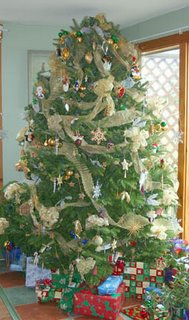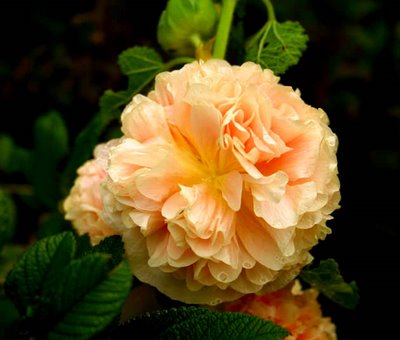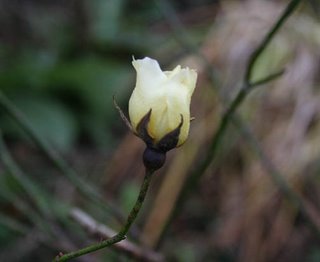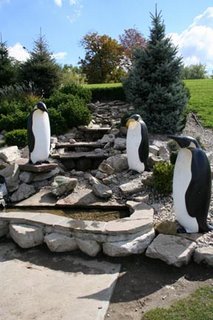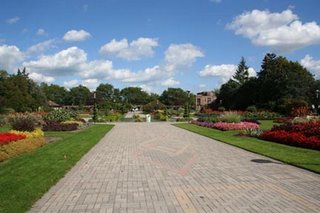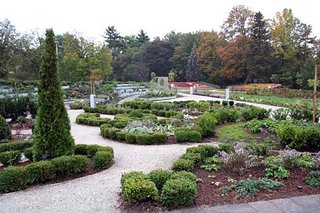High on my list of places you gotta go is
the Royal Botanical Gardens, located in Burlington/Hamilton. What a great time I had visiting this time. In 2005 I was in Hamilton for PWAC’s Annual General Meeting, and got to see a bit of the gardens, but not nearly enough. This time, however, I got a pretty thorough visit of much of the site, which is actually spread out over several different locales around the edge of Hamilton/Burlington.
Last time, I was at the Rock Gardens in late May, and they were awash in colour from the 100,000 plus bulbs, mostly tulips, planted there. Big sweeps of colour, vibrant and jewellike; now of course that garden is planted with a host of annuals to provide equal drifts of colour, and those will be coming out soon for the bulb planting session. The Rock Garden is neat because it’s set down in this hollow with huge, native rock structures on the hills of the “bowl”—nice dramatic rocks, and since this is part of the Niagara Escarpment, it’s hardly surprising to find rocks there.

It was built 75 years ago in what was an abandoned gravel pit, using local limestone—a great make-work project to help counteract the grim reality of the Depression. There aren’t only annuals and bulbs here, howeve—there are some wonderful water features, mature trees and shrubs, (including magnolias and flowering cherries, rhodos and azaleas), and lots of steps and terraces to climb and view the garden from. It’s a peaceful and beautiful space, and much loved by the citizens of the area.
The RBG Centre is, of course, the place to start an entire tour of the Gardens. My host Andrew King and I had lunch in the Gardens Café, then headed to the Mediterranean Garden, an indoor collection under glass (and a perfect place to go during the grey days of winter.) There are huge specimens in here, ranging from false agave to banana (at least I think it was a banana!) flamboyant flowering plants such as bouganvillea, passion flower and bird of paradise, a fine display of cacti and succulents, and even wonderful citrus trees (all with fruit on them). Children can enjoy the outdoor Discovery Garden, which has all kinds of wonderful activities for them to help them get interested in gardening early.
Along with the usual displays of plants and structures, the Gardens were playing host to another unique display of beauty while I was there.
ZimSculpt, a collection of Zimbabwean sculptures were nestled throughout Hendrie Park, looking like they had always been there--when in fact they were part of a touring exhibit--on its only stop in Canada--from that country, with the curator and three of the sculptors along for the trip, of course. They've spent a month in Burlington, have sold over 100,000 dollars worth of sculpture, and were hard at work making new pieces using single chunks of rock that they brought with them. Watching them was totally fascinating, and the sculptures were gorgeous...the tour is complete now, and they are heading homeward, but hopefully will be back again in the not too distant future.
Out the doors of the Centre, we enjoy the fountain court, where the cheery chiming of water from fountains provides the perfect anodyne to the rumble of nearby traffic. This terraced area is awash with annuals providing late season colour to push away even the dreariest of days—and it was dreary the day I visited. From there we walked into Hendrie Park, which is a huge, sprawling area with more than a dozen different theme gardens. The Centennial Rose Garden takes up a significant part of the Park, and you’d be surprised just how many roses are still blooming quite happily, even as we progress into October.

There are themed gardens for herbs and lilies, a wonderful medicinal garden, a clematis collection, more plots for children to enjoy, and the lovely tea house where you can pause and enjoy some refreshments before heading to the wild sanctuary of the woodland park known as Hendrie Valley Sanctuary. I loved this; we hiked down woodland trails, went through a clever fence designed to keep deer out of Hendrie Park proper, then across a lovely boardwalk over the wetlands area. What a pretty, peaceful spot; visitors were feeding wild birds, chipmunks and squirrels on the boardwalk rails, ducks were splashing and diving in a stream through the wetlands, and of course autumn glory was unfolding in the changing colours of hardwoods. Utterly lovely. We could have stayed a while, walked much further, but time was tickin’ by, and so we regretfully left this place and headed off to another site, Laking Garden.
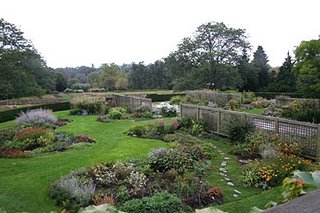
It was beginning to rain quite sincerely when we arrived at Laking, but we did pause to survey the domain from a lookout that gives the perfect view of the terraced gardens. The lowest terrace is currently a work in progress, as the iris beds are being converted from a series of rather dull beds to a more aesthetically appealing showcase for the some 600 cultivars of irises on display. I’d love to see THAT in flower—maybe another year! There’s a lovely old cottage at the top of the terraces, site of the Barbara Laking Heritage garden, which features many heirloom culticars of perennials and shrubs. The central terrace is dedicated to perennials, all kinds of perennials, including many new and improved cultivars. I really, REALLY enjoyed this area, despite the wet—well, I thought Laking in itself was pretty fine, a public spot any city would be proud to have, and yet it was only one section of the RBG.
By now, the rain was sincerely soggy, so my intrepid host suggested, as we had some three hours before my train, that we go off to Niagara to see the falls. It was too wet to go exploring gardens there and we knew we wouldn’t have that much time, but we sallied off down the highway and yakked a mile a minute about many things, while I gawked out windows at things like the Welland Canal, assorted vineyards, and such til we arrived in downtown Niagara Falls.
Well. What a strange place that is. Ever been there? Yikes! Clifton Hill is called the Entertainment and Dining district of Niagara Falls. I have one word to describe it—ultratacky! I’ve never seen so much neon, flashing lights, and bizarre displays enticing visitors; how about Frankenstein eating a burger on top of a fast food joint? King Kong hanging off another site? A wax museum—de rigeur in many tacky tourist traps—and of course, a plethora of casinos and nightclubs, all designed to separate the biker chicks, greaseballs, nearly destitute, nouveau riche and others from their money. I felt like I needed a shower just driving through the area. But you know what? It was all washed away, nearly literally, when we turned the corner and headed down to enjoy 12 dollar parking and the main attraction that gives the city its name—the real, genuine, and totally awesome Niagara Falls.
It’s hard to take a photo up close that shows the true magnificence and power of the Falls. All that energy, sound, fury, colour, cascading over the rapids and down over the dramatic drop to the river below. Utterly, completely mindblowingly wonderful. Never mind the horde of hotels on the hillside overlooking the Falls. Never mind the neon nightmare up the hill. Never mind the hordes of tacky souvenir shops. The falls are worth visiting, any time day or night.

And nyah, nyah, nyah nyah nyah, nyah…the Canadian falls are way, way more impressive than the wimpy American falls nearby. Ours are better than theirs….





















